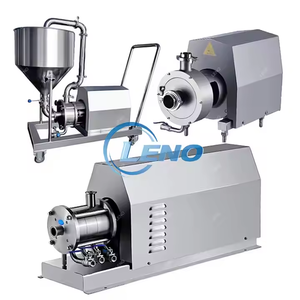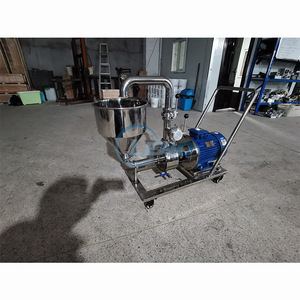
All categories
Featured selections
Trade Assurance
Buyer Central
Help Center
Get the app
Become a supplier

(18623 products available)




















The cosmetic cream making machine comes in different types, each with distinct features. The following table summarizes some of the main types:
Batch PLC
The Batch PLC control machine is a sophisticated tool with a primary PLC control system, and it helps to make many creams and emulsions. This machine stands out because it can control the batch it produces automatically, which is both good for productivity and efficient control.
Additionally, the Batch PLC-controlled cream making machine has a touchscreen interface where operators can easily program parameters like temperature, speed, and time. Because of this, it can make consistent, high-quality products that meet precise specifications.
Also, this cream machine can give numerous industries, such as the pharmaceutical, food, and cosmetic industries, large or small batches. In other words, it is a pleasant option because of its versatile use and efficient automation for various sectors.
Homogenizer
Generally, a cream-making machine homogenizer is a machine that makes creams and emulsions by homogenizing them. To put it another way, the process of homogenizing entails breaking down and dispersing ingredients evenly in a mixture.
This cream-making machine uses high-pressure shear forces to give various materials, including food, pharmaceuticals, and cosmetics, great stability and uniformity. This is made possible by the application of high-pressure shear forces to the material, which breaks up and evenly distributes the components of the material.
As a result, creams and emulsions that are produced are very smooth and uniform, with no separation or sedimentation happening over time. This shows that the cream-making machine homogenizer makes it possible to produce emulsion systems that are very stable and have a uniform dispersion of tiny particles.
Multi Vessel
The multi-vessel cosmetics cream-making machine means one in which several vessels or containers are used to make the cream. Each of these vessels has its own use and purpose for the overall process of making cream.
With these types of machines, the process of making creams is more flexible and can be scaled up. Also, the different vessels that are part of the system all come with a variety of features, like mixing, heating, cooling, and vacuum functions, to name a few.
As a result, the cream production process becomes integrated, which increases productivity and efficiency. In summary, the multi-vessel cosmetics cream-making machine is a key technology for producing high-quality creams in the beauty industry on a large scale.
Vacuum
A vacuum cream-making machine is a device that produces creams and emulsions using a vacuum. In short, this machine uses heat and pressure to melt and mix raw materials under a vacuum to make delicate, uniform emulsions.
In other words, this process removes air bubbles from the mixture while also preventing oxidation and contamination, which results in a final product that is smooth, shiny, and of high quality. The use of a vacuum during the process also enables efficient material extraction.
Moreover, because of their many uses and great performance, vacuum cream-making machines are essential in numerous fields, such as cosmetics, food, and medicine.
The cream-making machine has several specifications that users will find useful to know about. Besides, the machine requires a certain type of maintenance to ensure it continues working efficiently and producing great-quality cream.
Operating system
The main thing users need to keep an eye on is the operating system of the machine. The machine should have an easy operating system, which means an automatic control panel will that users will find simple to manage. Various control buttons, including the start/stop button, a digital timer, and additional options for adjusting the mixing speed, will be present on the panel.
Capacity
A cosmetic cream-making machine can hold anywhere from 5 to 1,000 liters of cream at a time. The capacity will usually depend on the size and model of the machine. Bigger models with more capacity are excellent for industrial use, while smaller models are for personal or small-scale use.
Mixing speed
The machine will have a motor and stirrer installed that will mix the ingredients at different speeds. Lowering and increasing the mixing speed depending on the needs of the process is common. The normal mixing rates are anywhere from 50 to 500 RPM.
Heating and cooling system
The cream needs to be heated or cooled down at times, and that is why the machine has a heating and cooling system. This system works using a water jacket that includes plates or coils. These plates and coils transfer heat to the material being processed so it can warm up. On the other hand, if it needs to cool down, cold water runs through the jacket.
Vacuum system
In order to avoid air bubbles in the final product, the machine will have a vacuum system. It functions by reducing pressure within the container, which causes any air bubbles or excess moisture to be released from the cream.
Users need to do regular inspections to ensure a cream machine-making machine continues to work well. They should check it for any signs of wear and tear. If any parts need to be replaced or repaired, users should do so immediately to avoid damage.
Clean the machine thoroughly before and after every use. This includes all parts of the machine, both externally and internally. If any part needs lubrication, see to it that it gets lubricated on time.
A cosmetic cream-making machine is an essential piece of equipment for manufacturers and research facilities. Its optimal environment is in a large-scale production setting, such as a factory or lab, where it is utilized to manufacture various products in massive quantities.
Cream-based skin product manufacturing:
The primary application is producing lotions, gels, emulsions, and other cream-based products in large quantities. The machine enables the large-scale production of skin care items daily, like moisturizers, sunscreens, anti-aging and nourishing creams, and more.
Diverse product types:
Because of its ability to modify formulation ideas and ingredients, the cream machine allows for the development of diverse cream types, such as hydrating, brightening, anti-wrinkle, soothing, sensitive skin, and fixing creams, as well as products like light-weight emulsions and rich face and body lotions.
Specialized ingredient inclusion:
The machine also makes it easy to incorporate active ingredients, plant extracts, vitamins, and other specialized components into the formulation, ensuring uniform distribution and effective incorporation.
Packaging:
The machine also allows manufacturers to customize the kind of packaging used as well as the sizes offered to different end-users. Products are made in bulk and packaged in either cosmetic jars or bottles suited for body, face, and hair use, which makes retailing a lot easier.
Customized formulation:
Cosmetic cream-making machines can also be used to create customized formulations for specific target markets. These could areas with very dry or humid climates where people may be more prone to skin problems and thus need products with particular attributes—factors like age range, gender, and cultural preferences also determine whether there is a demand for custom formulations.
Production capacity:
Macrodosage tanks, mixing vessels, and emulsion machines all have different production capacities. Determine how much cream the machine can produce within a specific timeframe. Choose a machine with a production capacity that aligns with the intended output to meet demand without causing bottlenecks in the production process.
Mixing technology:
Consider the mixing technology employed by the machine. Some machines use planetary mixing, while others may utilize scraping or shearing techniques. Choose a machine with a mixing technology that ensures uniform blending and dispersion of cream ingredients, resulting in consistent product quality.
Machine compatibility:
Consider the machine's compatibility with macrodosage tanks and mixing vessel requirements. Ensure the machine can seamlessly integrate with existing equipment or future expansion plans. This avoids compatibility issues and facilitates smooth workflow within the production facility.
Energy efficiency:
Consider the energy efficiency of the cream-making machine. Look for features like energy-saving motors or efficient mixing mechanisms to minimize energy consumption during operation. Choosing an energy-efficient machine contributes to cost savings and sustainable production practices.
Hygienic design:
Opt for a cream-making machine with a hygienic design that prioritizes cleanliness and easy maintenance. Machines with smooth surfaces, minimal crevices, and quick-cleaning components reduce the risk of product contamination and streamline cleaning processes to maintain strict hygiene standards.
Q1: What are the main components of a cream-making machine?
A1: The main components include a water phase container, an oil phase container, a homogenizer, a heating and cooling system, an automated control system, and a mixing vessel. Some advanced machines may also include an emulsifier, a vacuum pump, and a weighing system.
Q2: How does a cream-making machine work?
A2: The cream-making machine first heats and melts the solid ingredients in the oil phase container and then heats up the water in the water phase container. Once the oil and water phase ingredients are at the specified temperatures, the homogenizer starts to work and mix them together. The high speed creates a stable emulsion. Finally, the cooling system brings the temperature of the cream down and stores it in the mixing vessel.
Q3: What types of emulsions can cream-making machines produce?
A3: They can produce various types of emulsions, including oil-in-water (O/W) emulsions, water-in-oil (W/O) emulsions, multiple emulsions, and nonionic o/w emulsions.
Q4: Is a cosmetic cream-making machine easy to clean and maintain?
A4: Yes. Most contemporary machines are equipped with CIP systems for in-place cleaning. The automated control system ensures that the cleaning and maintenance processes are effective and consistent. Based on the recipe and production needs, a portion of the cream may be saved for cleaning purposes.
Q5: What safety features does a cream-making machine have?
A5: The cosmetic cream machine has several safety features, such as over-pressure, over-temperature, and motor overload protection. Depending on the machine's specifications and standards, the emergency stop button may also be included.